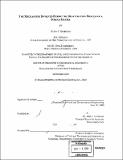| dc.contributor.advisor | John T. Germaine. | en_US |
| dc.contributor.author | Sjoblom, Kurt J. (Kurt John), 1965- | en_US |
| dc.contributor.other | Massachusetts Institute of Technology. Dept. of Civil and Environmental Engineering. | en_US |
| dc.date.accessioned | 2006-03-24T18:00:27Z | |
| dc.date.available | 2006-03-24T18:00:27Z | |
| dc.date.copyright | 2000 | en_US |
| dc.date.issued | 2000 | en_US |
| dc.identifier.uri | http://hdl.handle.net/1721.1/29890 | |
| dc.description | Thesis (Ph.D.)--Massachusetts Institute of Technology, Dept. of Civil and Environmental Engineering, 2000. | en_US |
| dc.description | Includes bibliographical references (p. 247-253). | en_US |
| dc.description.abstract | Traditionally, soil mechanics deals with soil in either of two states, saturated or dry. The effective stress concept proposed by Terzaghi has proven to be valid for soils in either of these states. However, when the water or air phase becomes large enough, the soil no longer behaves as two-phase system and the third phase must be considered. Unsaturated soil behavior has been argued to be a function of negative pore pressure or matric suction. All the unsaturated soil behavioral issues contain a single underlying question; what is the nature of soil suction? Nature refers to the physical phenomenon that generates soil suction and changes with environmental factors. The goal of this work is to provide an understanding of the generation of soil suction. Examining the drying process of porous material gave perspective into the development of negative pressures. The drying material was modeled by a regular packed matrix of equal diameter spheres. Configuring the water into the geometric shape of pendular rings simulated the water held in the matrix. A predictive model was then developed relating the water content of the matrix to the associated tension in the water. The model was tested using a unique measurement technique to determine a continuous drying curve of a porous material. The technique required the development of a tensiometer capable of directly measuring the high negative pressures. Glass beads of narrow distribution provided insight into the behavior of the drying pendular rings. It was determined that the actual tension to initiate draining is much greater than that predicted by the largest pendular ring. This reduced size of ring was also observed by a series of photographs of drying spheres. The information gained was then used to predict the tension of draining (or air entry pressure, AEP) for natural materials. Three types of soils were tested to validate this prediction. Finally, a literature search was done to obtain data for a wide variety of soils. The literature data provided a means to refine the prediction by relating the grain size distribution of the soil to the AEP. | en_US |
| dc.description.statementofresponsibility | by Kurt J. Sjoblom. | en_US |
| dc.format.extent | 334 p. | en_US |
| dc.format.extent | 12668635 bytes | |
| dc.format.extent | 12714457 bytes | |
| dc.format.mimetype | application/pdf | |
| dc.format.mimetype | application/pdf | |
| dc.language.iso | eng | en_US |
| dc.publisher | Massachusetts Institute of Technology | en_US |
| dc.rights | M.I.T. theses are protected by copyright. They may be viewed from this source for any purpose, but reproduction or distribution in any format is prohibited without written permission. See provided URL for inquiries about permission. | en_US |
| dc.rights.uri | http://dspace.mit.edu/handle/1721.1/7582 | |
| dc.subject | Civil and Environmental Engineering. | en_US |
| dc.title | The mechanisms involved during the desaturation process of a porous matrix | en_US |
| dc.type | Thesis | en_US |
| dc.description.degree | Ph.D. | en_US |
| dc.contributor.department | Massachusetts Institute of Technology. Department of Civil and Environmental Engineering | |
| dc.identifier.oclc | 48245212 | en_US |
